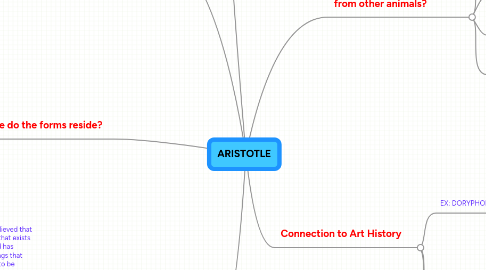
1. Aristotle's Biology
1.1. Metophysics
1.1.1. Aristotle states, "All men by nature desire to know. An example is the delight we take in our senses."
1.1.2. He believes that natures does nothing by chance.
1.1.3. We have been given senses [as tools] to use them to understand the world.
1.2. For Aristotle, to engage the problem of knowledge, we must begin with our senses.
1.2.1. Therefore fundamentally disagreeing with Plato.
2. How does Aristotle differ from Plato and Socrates?
2.1. Aristotle does not believe in the World of Forms, but thinks that everything that he can understand are the things we can touch.
2.2. He creates and applies a scientific model to philosophical investigation.
3. What is teleological system?
3.1. Aristotle believed that everything that exists in this world has causes [things that drive them to be created].
3.2. He provides 4 causes:
3.2.1. MATERIAL CAUSE: the material from which the thing is made
3.2.1.1. the material it is made of
3.2.2. FORMAL CAUSE: the shape or form a thing must take in order to be recognized
3.2.2.1. physical characteristics
3.2.3. EFFICIENT CAUSE: the actual force used to make the thing
3.2.3.1. the tools used to create it
3.2.4. FINAL CAUSE: what is the ultimate purpose of the thing
3.2.4.1. why is/was it made?
4. Where do the forms reside?
4.1. Aristotle believes that the forms lie inside the things themselves.
4.1.1. EX: the form of the oak tree is inside of the acorn
4.2. Each thing that we see is a part of a teleological [goal oriented] system.
5. How do our senses differ from other animals?
5.1. All forms of life have nutritive, reproductive, and locomotive power.
5.2. All animals differ by having the power of sensation and perception [unlike plants].
5.3. More complex animals have intellectual power [power solving ability; humans].
5.4. Aristotle argues that humans have a special intellectual power called reason.
5.4.1. REASON is the ability to comprehend universal principles.
6. Connection to Art History
6.1. EX: DORYPHOROS
6.1.1. MATERIAL CAUSE: marble/bronze
6.1.2. FORMAL CAUSE: human shape & nude; built with mathematical precision
6.1.2.1. Polykleitos [the sculptor] was a Pythatorean
6.1.3. EFFICIENT CAUSE: chisel, hammer
6.1.4. FINAL CAUSE: didactic art [made to teach], meant to teach us about Greek virtues
6.1.4.1. Virtue of Strength: athlete [muscles]
6.1.4.2. Virtue of Intellect: in a position of thought/reason
6.1.4.3. REASON CONTROLS THE STRENGTH
